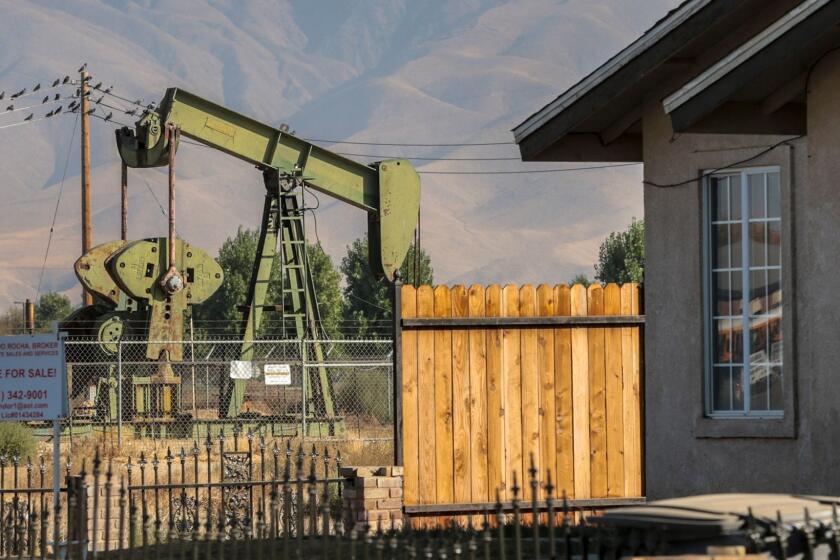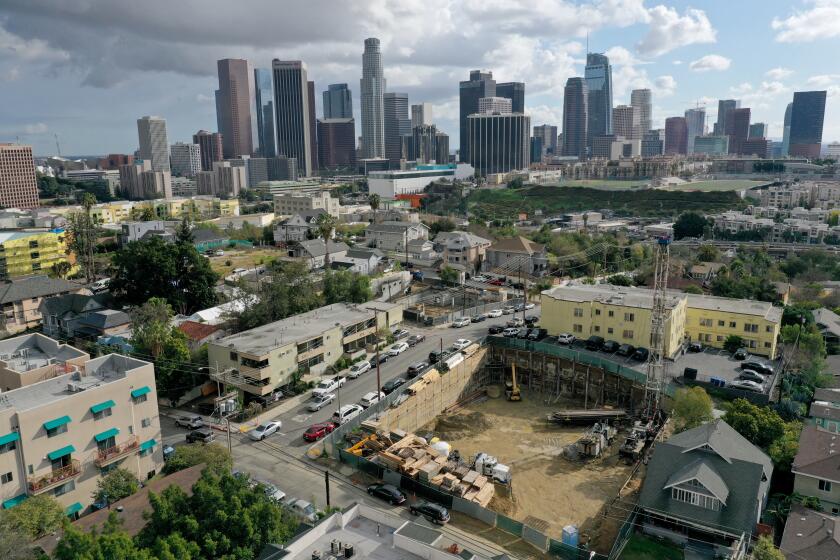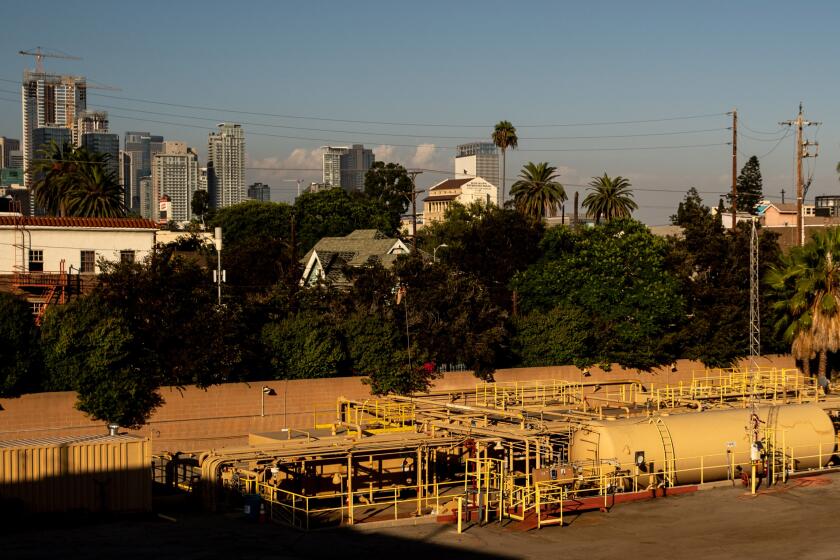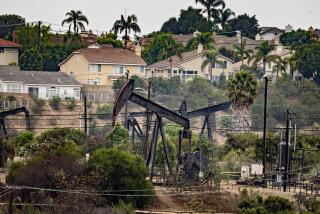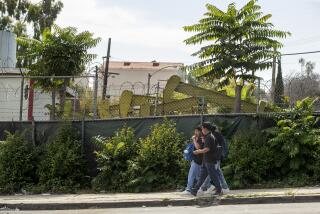New California oil drilling must be set back from homes and schools, Newsom says
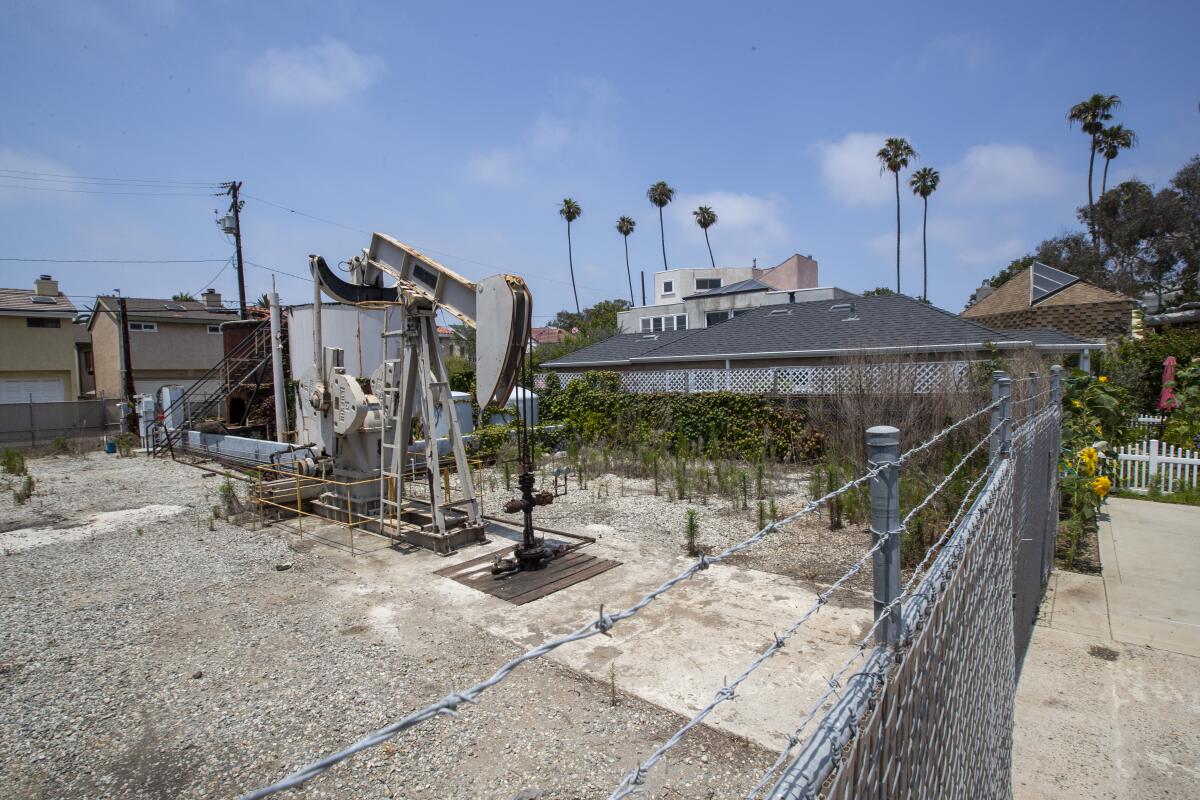
- Share via
SACRAMENTO — The Newsom administration on Thursday took the first step toward banning new oil and gas wells within 3,200 feet of homes, schools and healthcare facilities, and requiring emissions monitoring of existing wells within those buffer zones, a move urged by environmental and public health advocates who say the toxins, odors and hazards from oil fields disproportionately affect Latino and Black communities.
The proposed state regulation is expected to affect more than 2 million residents who live within health and safety zones, as well as thousands of existing wells in the urban oil fields of Los Angeles County and in Kern County, the heart of California oil country.
Still, the new restrictions would probably not go into effect until 2023 because of the state’s arduous process of crafting new regulations, and portions could be changed along the way. The proposal is expected to face an aggressive challenge from California’s billion-dollar oil industry.
Gov. Gavin Newsom said the driving force behind the regulation is the public health risk linked to oil and gas production, with studies showing increased risks for cancer and adverse health effects for pregnant women and newborn babies, along with incidence of asthma and other ailments.
“This is about public health, public safety, clean air, clean water,” Newsom said at a press conference at the Wilmington Boys & Girls Club, which neighbors one of many oil wells in Southern California. “This is about our kids and our grandkids and our future. A greener, cleaner, brighter, more resilient future is in our grasp.”
A panel of 15 health and science experts reviewed setback regulations in other states as well as studies on the health hazards oil and gas well pose to people living or working nearby and determined that a 3,200-foot buffer zone — equal to roughly one kilometer or just over half a mile — was needed since “studies consistently demonstrate evidence of harm at distances less than 1 km.”
“Extracting oil is a dirty business and it’s had a real impact on Californians,” said Jared Blumenfeld, secretary of the California Environmental Protection Agency. “If any of us had to live next to a pump jack or oil facility, we’d be worried every day about our family’s health.”
Blumenfeld said the overriding focus of the proposed regulation is to protect “the most vulnerable among us,” because people who live near oil and gas wells hew toward the lower end of the economic spectrum. Lauren Sanchez, the governor’s senior advisor on climate issues, said the new regulation “was really about righting the wrongs of the legacy of oil and gas drilling predominantly in communities of color, but essentially wherever they pleased — next to day cares, next to hospitals.”
Unlike Texas, Colorado and Pennsylvania, California has never enacted setbacks from oil and gas wells despite being among the most progressive states in the nation on environmental protection and combating climate change. Proposals to mandate the buffer zones failed to pass in the California Legislature in 2020 and again this year, a testament to political influence wielded by the petroleum industry and trade unions.
The proposal comes as yet another blow to an industry facing intense public scrutiny for a massive oil spill off Huntington Beach this month and the lingering effects of the 2015 Aliso Canyon natural gas leak that forced thousands of families to evacuate in the northwest San Fernando Valley.
During his first year in office, Newsom ordered the state Department of Conservation’s Geologic Energy Management Division (CalGEM) to study the possible adoption of buffer zones around oil wells. The agency crafted the regulations after holding public hearings around the state. If adopted by the agency, California’s 3,200-foot buffer zone would be the largest in any state.
The proposal was initially set to be released to the public at the end of 2020 before it was postponed until spring. No explanation was provided for the delayed timing of the announcement made Thursday.
The new restrictions would continue the state’s slow-moving divorce from a once giant oil and gas industry that has seen a steady drop in production over the last quarter-century in California.
In April, Newsom took action to ban new permits for hydraulic fracturing starting in 2024, halting the controversial oil extraction method that’s been targeted by environmental activists for years. The ban is mostly symbolic, however, because fracking accounts for just 2% of oil production in the state, according to the Department of Conservation.
Hundreds of unplugged oil wells puncture the urban landscape of Los Angeles. But the city has been reluctant to use its full powers to ensure cleanup and protect the public.
The governor also called on the California Air Resources Board to determine how to end all oil extraction in the state by 2045. The governor’s office said that plan would dovetail with California’s effort to achieve economy-wide carbon neutrality by 2045, including Newsom’s call to ban the sale of new gas-powered vehicles in the state by 2035.
“We don’t see oil in our future,” Newsom said Thursday.
In September, the Los Angeles County Board of Supervisors unanimously voted to ban new oil wells and evaluate the status of existing ones. Existing oil wells cannot legally be shut down until owners recoup the costs of drilling, a cost the county also is reviewing.
The oil wells in Los Angeles County — both on- and offshore — produced 11.7 million barrels of oil in 2019, making L.A. the second-largest oil-producing county in the state. Kern County produced more than 110 million barrels, according to CalGEM, which regulates the oil and gas industry.
A study by researchers at UC Berkeley and published by the National Institutes of Health found that living near oil and gas wells caused significant adverse health effects to pregnant women and newborn babies. A 2014 report by the Natural Resources Defense Council determined that more than 5.4 million Californians lived within one mile of at least one oil or gas well.
Since taking office, Newsom has faced pressure from influential environmental groups to ban new oil and gas drilling, and completely phase out fossil fuel extraction in the state. But the Democratic governor has taken a more measured approach, taking into consideration the effects on oil workers along with California cities and counties that are economically dependent on the petroleum industry.
L.A. has hundreds of active oil wells. Council members asked 2½ years ago for a new ordinance mandating annual inspections of oil sites, but no such law has been approved.
“We have to commit to the hard work of taking care of those who are taking care of their families [and] working hard on these fossil fuel sites,” Newsom said Thursday. “We have to give them a pathway to a cleaner, greener, cheaper, more reliable future.”
Wade Crowfoot, secretary of the California Natural Resources Agency, said the state cannot heed the calls of environmental justice advocates to shut down or phase out oil and gas wells within the buffer zones if operators received a legal permit from the state, due to their property and mineral rights.
Crowfoot said, however, that the proposed regulation requires oil and gas companies to monitor and prevent emissions and other threats from all active wells within the 3,200-foot buffer zones. Under the proposal, all wells would be required to have safety systems to detect emissions and leaks, as well as capture any vapors. Groundwater monitoring around the site also would be required.
“I’m confident in saying this is the strongest set of engineering controls and protective mitigation measures anywhere in the country, if not the world,” Crowfoot said. “We do anticipate that some producers will choose to safely and permanently seal their well and stop producing as a result of this cost.”
Newsom said that nearly 30% of the oil operations in California would be affected by the proposed regulation.
The state, which has championed and pioneered progressive environmental policies to slash carbon emissions, is also home to a billion-dollar oil industry that helps power its economy and has significant political sway in Sacramento. Despite declines in production, California remains the seventh-largest crude oil producing state in the nation, according to the U.S. Energy Information Administration.
Oil industry representatives for years have argued against setbacks, saying doing so would eliminate thousands of well-paying jobs and devastate communities that rely heavily economically on the petroleum industry. They have also maintained that because demand for gasoline, diesel and jet fuel will not cease overnight, oil would have to be imported from countries that don’t have the strict environmental and worker safety protections that exist in California.
Catherine Reheis-Boyd, president and chief executive of the Western States Petroleum Assn., said the oil and gas industry does not oppose setbacks that are based on “science, data and rigorous health assessments” and accused the Newsom administration of failing to meet that standard.
“The proposed rule’s true setbacks will be imposed upon California’s families, workers and businesses that need affordable, reliable energy every day,” she said in a statement. “This was not a scientific process, as facts do not support the recommendation, nor were dissenting voices or industry experts even allowed to provide input to the panel.”
Assemblyman Vince Fong (R-Bakersfield) ripped the proposal. With the average cost of a gallon of gas hitting $4.53, the state should be encouraging more oil production in the state, not less, he said.
“At a time when Californians need affordable and reliable energy, the governor is once again choosing to increase energy costs, reduce needed energy production, and puts jobs and careers at risk in Kern County and throughout the state,” Fong said in a statement.
Environmental justice and public health groups praised Thursday’s announcement, a move they’ve long been pushing.
“We are tired of being treated like sacrifice zones, with dangerous health impacts of living next to oil production, including higher rates of asthma and respiratory illness, low birth weights and adverse birth incomes, heart disease and more,” Darryl Molina Sarmiento, executive director of Communities for a Better Environment, said at Thursday’s news conference with the governor. “The fight isn’t over. We know there is no safe distance from oil and communities. We need drilling operations phased out in our communities with robust plans to put in place to protect workers and communities.”
Still, some environmental advocates expressed disappointment that the Newsom administration wasn’t being more aggressive about shutting down existing oil wells and continues to issue well-drilling permits.
California was home to more than 61,000 oil-producing wells that produced 159 million barrels of crude oil from both onshore and offshore facilities in 2019, according to the state Department of Conservation. California also consumes more gasoline than any other state — 360 million barrels in 2019, according to the U.S. Energy Information Administration.
In 2018, a report by the Los Angeles County Department of Public Health called for greater health and safety setback requirements on new oil and gas wells, keeping them at least 300 feet from populated areas. It also called for a significant increase in air quality monitoring within the 68 active oil fields in the Los Angeles Basin.
“Although oil and gas production in Los Angeles County occurs in both rural and urban areas, the potential public health impacts of oil and gas sites located in densely populated areas are concerning, particularly to those who experience disproportionate economic and health inequities,” the report stated.
Oil rigs, storage tanks and other operations are common sights in Wilmington, Long Beach, Signal Hill, Torrance and South Los Angeles, where oil production has plagued neighborhoods with foul odors, noise and occasional spills or refinery explosions.
The Inglewood Oil Field in Baldwin Hills and Culver City covers 1,000 acres and is one of the nation’s largest urban oil fields. Over the last decade, the oil field has produced a yearly average of 2.5 million to 3.1 million barrels of oil, according to its owner, Sentinel Peak Resources.
The most publicized and politically charged case highlighting the dangers of oil and gas extraction in Southern California came in 2015, when a gas leak in the affluent San Fernando Valley community of Porter Ranch caused thousands of residents to evacuate and triggered complaints of nosebleeds, nausea and headaches. Southern California Gas Co. agreed to pay $119.5 million to settle lawsuits brought by state and local agencies.
More to Read
Sign up for Essential California
The most important California stories and recommendations in your inbox every morning.
You may occasionally receive promotional content from the Los Angeles Times.
